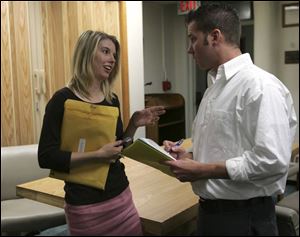
Student learned her lessons in council
10/9/2005
Sarah Tomashefski, now 26, talks with council candidate Gordy Heminger after a Bowling Green City Council meeting. After serving since 1999, she is not running for re-election.
BOWLING GREEN - Sarah Tomashefski had lived here less than two years when she decided to run for City Council. She didn't own a home, didn't have a job, and had never run for political office.
Still, the 20-year-old had something in common with just about half of the city's population: She was a student at Bowling Green State University.
"People kept asking me if I was running to have something to put on my resume, but it was never a resume builder. At that point, I didn't know enough to know that it would be," she said. "I really liked the community. I wanted to be involved somehow, and it really seemed to be a good fit."
In 1999, the Lakewood, Ohio, native became the sixth BGSU student since 1988 to represent the city's First Ward, and after running three successful campaigns, she is also the longest-serving student on council.
Having a college student on City Council, observers say, adds a different dimension to the mix of citizen representatives.
"I think they keep us all aware of points of view that we might not have been aware of," said Mayor John Quinn, who taught history and government for 30 years in the city schools.
Roger Anderson, a former council member and retired political science professor at BGSU, said students first took a stab at running for elected office in Bowling Green in the 1970s, but none was successful until the local Republican and Democratic parties got behind them in the late 1980s. He said serving on City Council is a great learning experience for the students and good for the city too.
"I think that when there are issues that involve conflicts between the community and the university, the students on council have played a mediator role in a better way than a non-student would," Mr. Anderson said.
"The views of students and university people are important in a community like this," he added. "Not everyone agrees with that, and a lot of people would say just the opposite - they're just here a short time, so who do they represent?"
Until Ms. Tomashefski, no student/council member had served more than a single two-year term, and her predecessor, Julie Meyer, left before her term was up - something voters remembered when Ms. Tomashefski was campaigning in 1999.
"The No. 1 thing I heard from permanent residents was were you going to leave early? I made a commitment that I wouldn't leave early if I got elected," she said.
The commitment to city government has meant that at times her social life suffered, occasionally her grades suffered, but for the most part she said she viewed her work for the city taking the place of a part-time job she might have otherwise held.
Now 26, Ms. Tomashefski completed both undergraduate and graduate school at BGSU, worked in the city for about 1 1/2 years, then enrolled in law school at Ohio Northern University in Ada.
She still lives in Bowling Green but decided not to seek a fourth term this November. There are two BGSU students - both Republicans - on the ballot challenging nonstudent candidates in both the First and Second Ward council races.
Ms. Tomashefski said they may be surprised to see how little of the business City Council conducts involved college students.
"I would say 85 to 90 percent of your issues have no direct link to students. They're passing budgets, passing zoning, dealing with employee issues, nothing that has a direct link to students," she said.
The issues that have prompted the most controversy - nuisance parties, occupancy limits, and student housing developments - have been student-related, though. And those are the times that can try a student/council member's soul.
"I think they see a bigger perspective once they're on council than what they had coming in," Mayor Quinn said, adding that the biggest problem he's seen students on City Council face is fellow students "who think they sold them out."
Ms. Tomashefski, a Democrat, concedes she hasn't always agreed with other students on issues, including last year's controversial debate over the city's 30-year-old law that says no more than three unrelated persons may live in the same house in residential neighborhoods. She took some heat for not fighting to change the law.
"You don't change laws to suit people who are breaking them," she said, referring to landlords who knowingly rent houses to more than three students.
Ms. Tomashefski likes the idea of having a student on City Council but said that can't be a candidate's only qualification. They ought to be involved in organizations on and off campus, and they need to attend council meetings before they run for election to get a feel for the process and the issues.
"I think that it's important that there always be someone to represent BGSU's interests on City Council," Ms. Tomashefski said. "When I was a student and I first ran, I thought it's got to be a student. It's got to be a student, but I also think there's something to be said for having someone with ties to both the university and the community whether they're a student, staff, or faculty member."
She said she believes her most lasting contribution was to help defeat a 2001 charter amendment that would have eliminated the city's four wards and made all seven council seats at-large. Had the amendment passed, it would have been difficult for students to be elected.
"In two years, no one is going to remember I was on City Council, but in two years whether there's someone from BGSU on city council is going to have a large impact on the community," she said.
Contact Jennifer Feehan at:
jfeehan@theblade.com
or 419-353-5972.